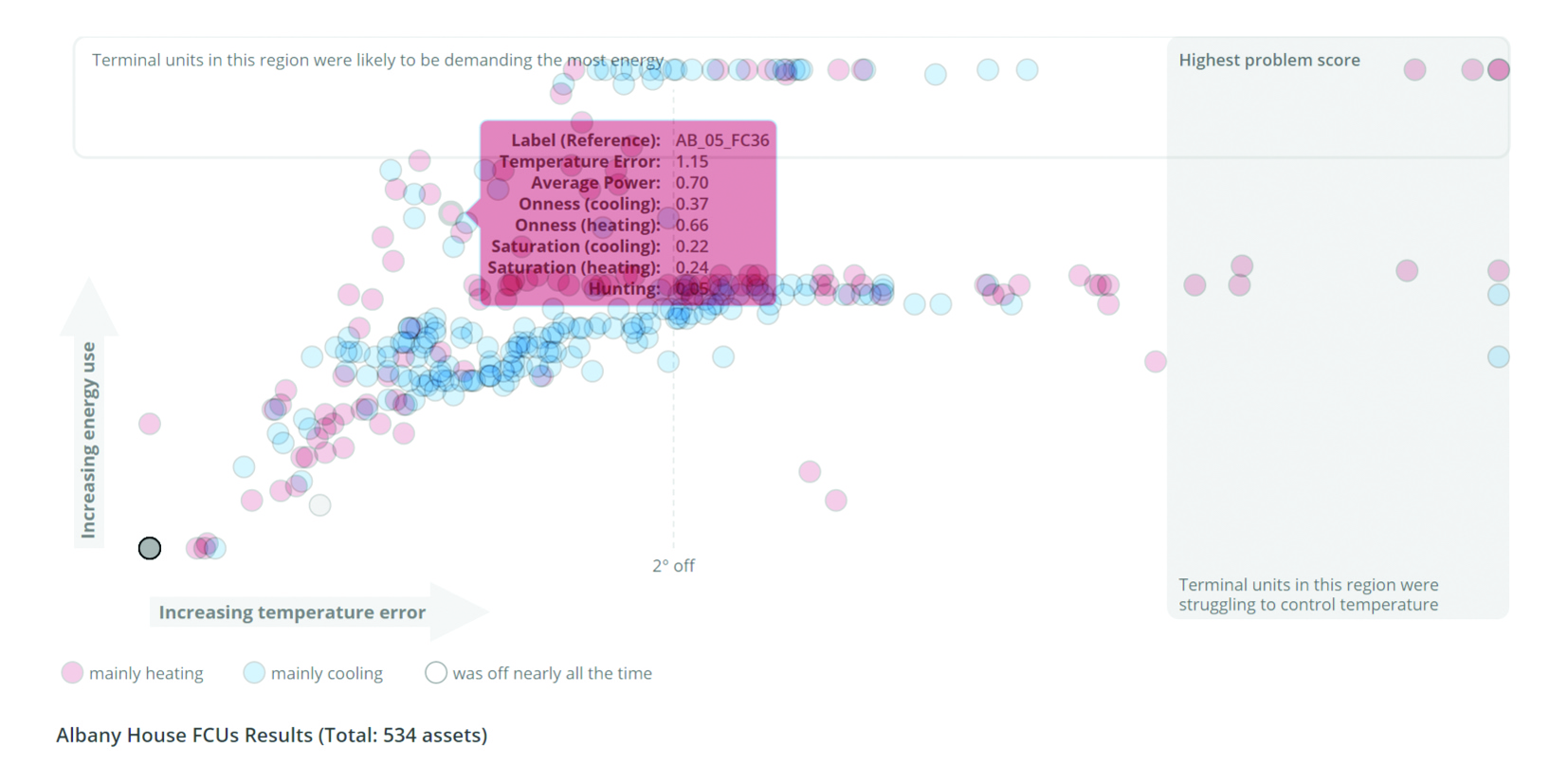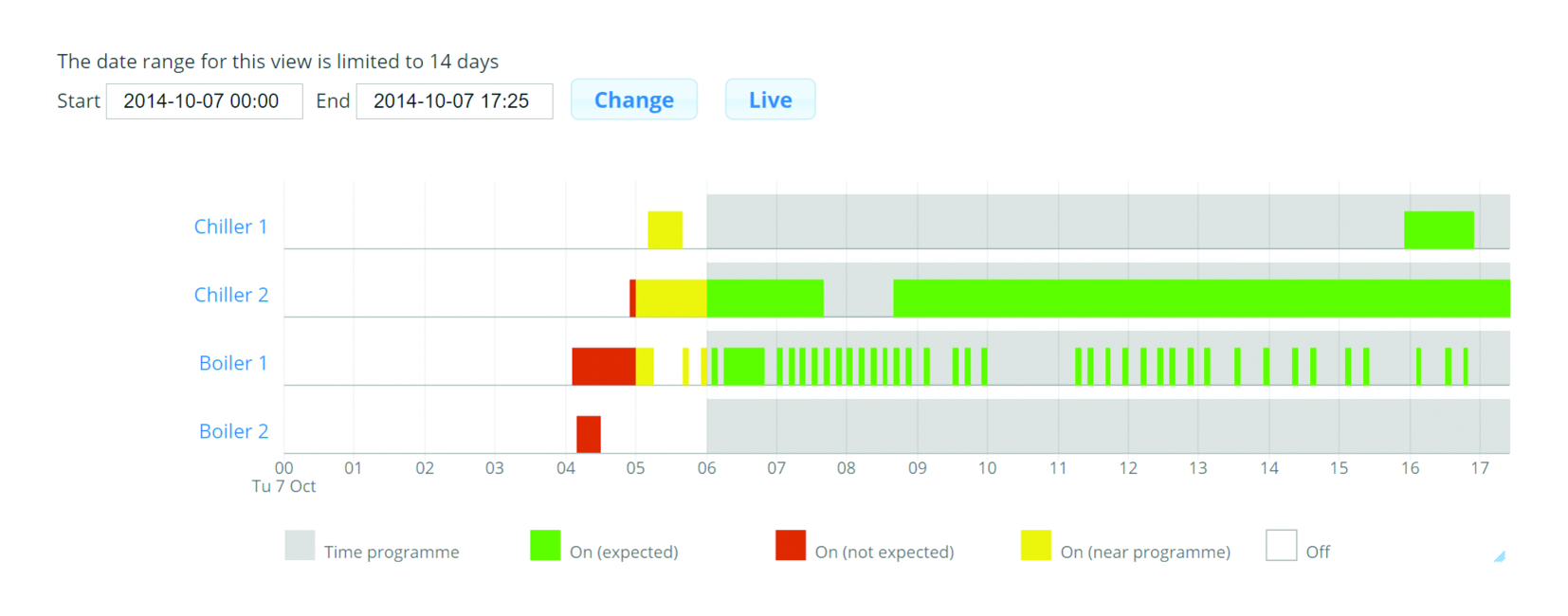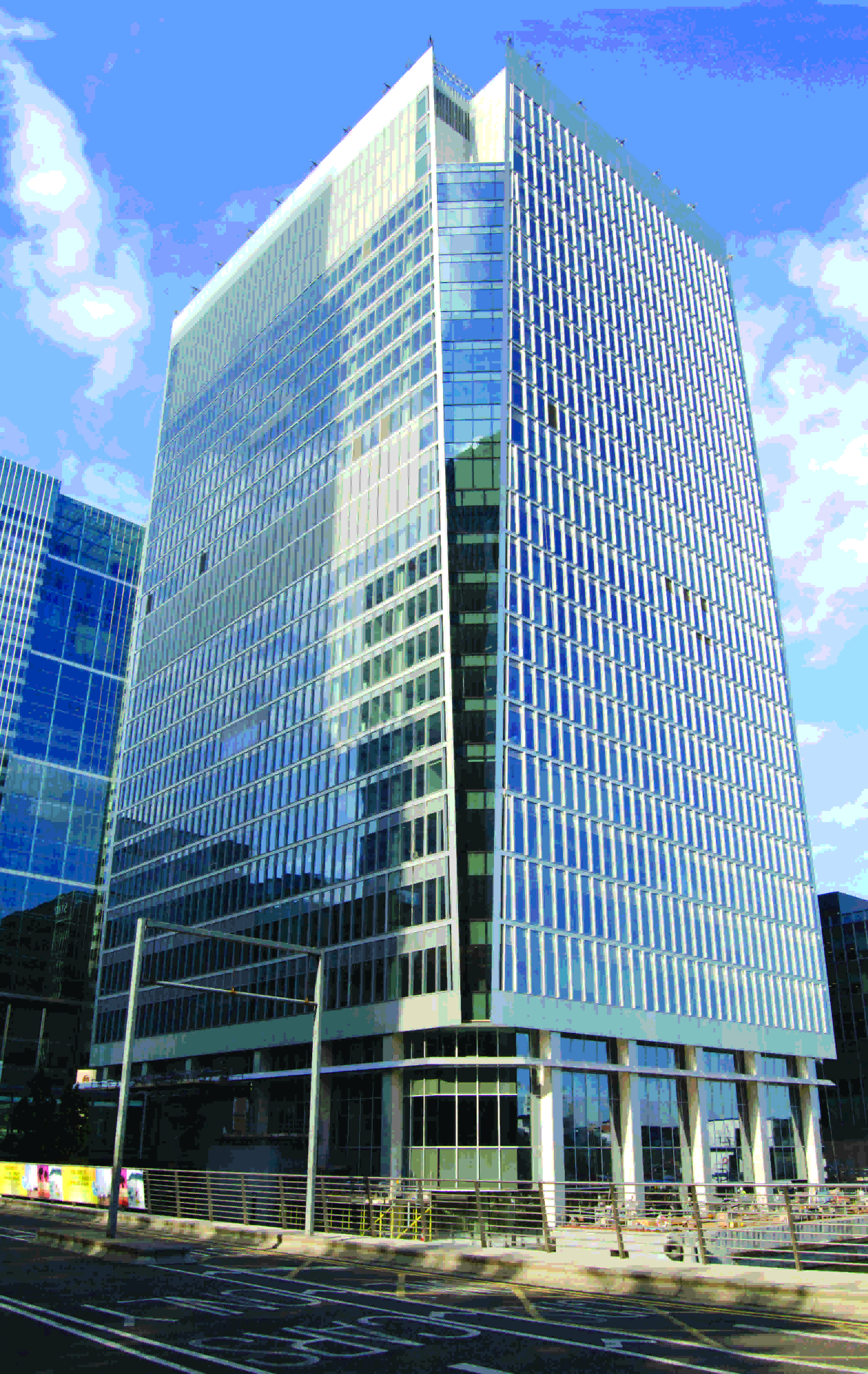
It can be time consuming to identify faulty or incorrectly set HVAC controls. They can have an adverse affect on comfort levels and lead to high levels of wasted energy – yet finding information in a building management system (BMS) to optimise performance can be painstaking. Busy facilities management (FM) teams can end up responding to occupier complaints rather than proactively managing efficiency.
In 2013, Demand Logic launched a system that monitors thousands of HVAC and meter data points, and finds the ones making excessive demands on the plant, causing comfort problems and wasting energy. In the pilot project at King’s College, London, the system identified opportunities to save at least £390,000 in annual energy costs. (See Knowledge is power, CIBSE Journal, December 2014).

This Demand Logic rogue finder graphic for Albany House identified individual faulty fan coil units making plant run unnecessarily. The building team investigated and fixed the problem, saving them time checking units in difficult-to-access areas
The system is now being adopted by some of the UK’s largest property companies. Members of the Better Building Partnership – including Canary Wharf Group, Land Securities, M&G Real Estate, TH Real Estate, The Crown Estate and Transport for London – are all using Demand Logic to improve building performance.
The system collects data through the BMS and analyses it, producing simple graphics and tables that help building teams identify potential operational improvements. By making HVAC and meter data immediately accessible via a familiar social media tool, these BBP members are improving energy efficiency, increasing comfort levels, saving on maintenance time, reducing their energy bills and cutting CO2 emissions.

M&G Real Estate, 3 Temple Quay: This major plant watchdog graphic identified boilers and chillers running at the same time (green) and boilers running out of hours (red), which the building team investigated and resolved
In most large commercial buildings, the internal environment is managed by the HVAC system, which typically includes boilers, chillers and air handling units. These are controlled and monitored by a BMS. The plant responds to hundreds of smaller devices, such as fan coil units, asking for hot or cold water, or air.
Financing – the facts
- Companies pay an annual subscription, which includes installation, access to the online platform, remote support from Demand Logic’s engineers and reviews of progress on actions
- Average energy cost savings: 10%-30%
- Average payback: within nine months
- Helps deliver £1.8m of energy cost savings annually for BBP members and occupiers
A device fitted to the BMS sends data to Demand Logic’s cloud service, where software analyses it, producing live graphics and tables of equipment and building performance. Building managers can log on to view these graphics via an online platform, sort information in tables, chat about the action required and take maintenance action to address anomalies.
BBP members have installed Demand Logic across buildings of different ages, sizes and uses. In less than two years, the system is identifying £1.8m of savings per year and cutting building energy costs by between 10% and 30%. Here are the biggest wins:
Canary Wharf
In 2015, Canary Wharf Group awarded Demand Logic a £50,000 Cognicity Challenge prize and the opportunity to implement its technology at Canary Wharf.
The installation and pilot of Demand Logic’s technology in 25 Churchill Place – a 50,630m2 office building – identified annual energy efficiency savings of more than £100,000 and improved temperature control.
Benefits for BBP members
Maximising the use of BMS data has helped:
- Improve comfort levels for building users, proactively managing temperatures, lighting and air quality – for example, reducing likely hot and cold spots
- Building teams to track down malfunctioning equipment quickly, saving time and money on maintenance, particularly for equipment in difficult-to-access areas. It has also extended plant lifespans and enabled transitioning to condition-based maintenance, improving building comfort levels and efficiency
- Support and streamline the commissioning process, confirming that equipment has been installed and configured correctly through automatic fault detection
- Provide a user-friendly social media interface for building teams, making data immediately accessible in a familiar format – including a table view that allows a rapid overview of many devices and filtering for conditions
- Save 11,800 tonnes of CO2 each year.
Land Securities
Land Securities uses Demand Logic across more than 232,200m2 of office, retail and other space, after a pilot at Dashwood House – a 14,770m2 office building – contributed to £100,000 of savings in the first year.
At 20 Fenchurch Street, a 63,900m2 joint venture development with Canary Wharf Group, Land Securities installed Demand Logic during fit-out commissioning, monitoring 175,000 data points in real time. This enabled the team to resolve issues more quickly, not only for the base building but also for the fit-out works. For instance, when one occupier experienced problems during fit-out, the graphics clearly showed the spikes in consumption on their floor, and the fit-out team could quickly rectify the issue.
M&G Real Estate

25 Churchill Place
M&G Real Estate uses Demand Logic with property services company CBRE at 3 Temple Quay. In the first six months, 49 energy-saving opportunities were identified. Those already implemented are delivering annual savings of £19,400 and cutting CO2 emissions by 260 tonnes.
TH Real Estate
TH Real Estate used Demand Logic during the commissioning of The Steward Building, a 4,500m2 office development, to analyse 25,000 data points. Altogether 70 actions were flagged, with 45 resolved before practical completion and others further investigated, improving the commissioning process. Specific issues were identified on 20% of 136 chilled beams. Demand Logic is now used in several other TH Real Estate buildings, including 133 Houndsditch (18,580m2), where savings of up to £50,000 have been identified.
Transport for London
TfL uses Demand Logic across 98,000m2 of office space, giving improved interaction between engineering managers and service providers, as well as identifying faulty equipment, heating and cooling systems running out of hours, and space being heated and cooled at the same time.
Using Demand Logic during commissioning
When Land Securities started to understand the capabilities of the system, the team was keen to trial Demand Logic during the commissioning process.
This initially proved challenging, however, because of contractors’ resistance to accepting new technology at a late stage in the process, when they believed it could affect their ability to meet the project programme. To overcome this issue, Land Securities is now writing this requirement into its construction contracts early on.
TH Real Estate also wrote Demand Logic into commissioning contracts for The Steward Building, where the remote analysis improved the process, identifying snags in the HVAC control system – particularly errors in time schedules and terminal unit performance that would commonly only become apparent on occupancy of the building.
Working with different BMS systems
After trialling Demand Logic on a Trend BMS, Land Securities wanted to use it in other buildings. But, initially, the system was not compatible with the BACnet protocol, an open international standard used by major BMS manufacturers. This was addressed when Demand Logic – together with Environmental Design Solutions (EDSL), London South Bank University and sustainability consultancy Verco – secured Innovate UK funding to test and develop a BACnet communications protocol. For the pilot, Land Securities provided One New Change, a 52,300m2 building, combining commercial offices and retail space that is one of the largest BACnet sites in Europe. Through this study, Demand Logic has developed a BACnet version of its system, which is now used in the UK and USA.
To read the article in full, visit the Better Building Partnership.
